These days, many IT and development teams are using Agile practices to build new products and meet project goals.
What this shows is that a growing number of teams inside and outside of software development are continuing to adopt Agile as a way to prioritize stakeholder feedback and work quickly to implement it.
To better understand the benefits of Agile practices and why so many businesses are using this methodology, we’re going to examine Agile ceremonies, which are the four specific meetings that bring structure to Scrum frameworks. We’ll also look at how a work platform like monday dev can help teams make the most of each ceremony and improve Scrum workflows.
What are Agile ceremonies (meetings)?
Agile ceremonies are meetings with defined lengths, frequencies, and goals. Their purpose is to help project teams plan, track, and engage stakeholders with their work and help them reflect on how well they’ve worked together. They’re typically a part of the Scrum framework of Agile project management. Projects that follow the Scrum framework deliver work in short bursts called sprints. Each sprint has a specific goal and lasts, on average, 2 weeks.
The Scrum framework has several defined roles. One of them, the Product Owner, maintains and prioritizes a list of required project deliverables, known as the product backlog. The Product Owner’s role is to represent the interest of business stakeholders and, at the beginning of each sprint, work with the project team to decide which deliverable should be tackled next.
<div class=”trd-ph-embedded” data-id=”ea70428e-3747-483e-8a3e-b535d281e67d”></div>
There are four core “ceremonies” or meetings that happen during each sprint. When managed correctly, these ceremonies support high levels of productivity and effective communication and collaboration between the project team and its stakeholders.
Read also: Introduction to Agile project management
Characteristics of successful Agile ceremonies
While every team may operate differently, successful Agile ceremonies share certain characteristics. Overall, respecting the structure of Agile ceremonies and sticking to the goal of each one will help them run smoothly. Some commonly shared characteristics of Agile ceremonies include:
- Open communication between stakeholders, managers, and team members
- Time-boxed ceremonies that respect time limits and cadence of the development process
- Setting plans ahead of time to respect each ceremony’s agenda
- Adapting to changing circumstances
- Facilitators such as Scrum Master or manager to ensure ceremonies stay on track
- Constantly fine-tuning ceremonies and asking for feedback to make improvements
4 key Agile ceremonies
Now that we’ve got a handle on exactly what Agile ceremonies are and their purpose, let’s look at each ceremony in a little more detail. Additionally, we’ll also examine how a work tool like monday dev can help teams manage, organize, and plan each Agile ceremony for maximum efficiency.
1. Sprint planning ceremony
- Goal: Establish the desired outcome for the upcoming sprint, define what backlog items can be accomplished, and determine how to achieve each item.
- Participants: The entire Scrum team, including the Product Owner.
- Frequency: At the beginning of each sprint, usually every 1–4 weeks, depending on the sprint length.
- Length: Up to 2 hours for every week of the sprint (eg. a 4-hour meeting for a 2-week sprint)
Sprint planning meetings set out precisely what the team will accomplish during the sprint. The Product Owner is responsible for bringing company feedback and an up-to-date and prioritized product backlog to the meeting.
However, the project team doesn’t automatically take the top-priority items from the product backlog as business requirements need to be considered first. This means that a sprint planning meeting can require some negotiation before a sprint backlog is finalized. The sprint backlog represents the list of tasks or product features that will be delivered during a single sprint.
In monday dev, it’s simple to stay on top of your sprint planning. With customizable boards and drag-and-drop functionality, you can easily navigate between your product and sprint backlogs.
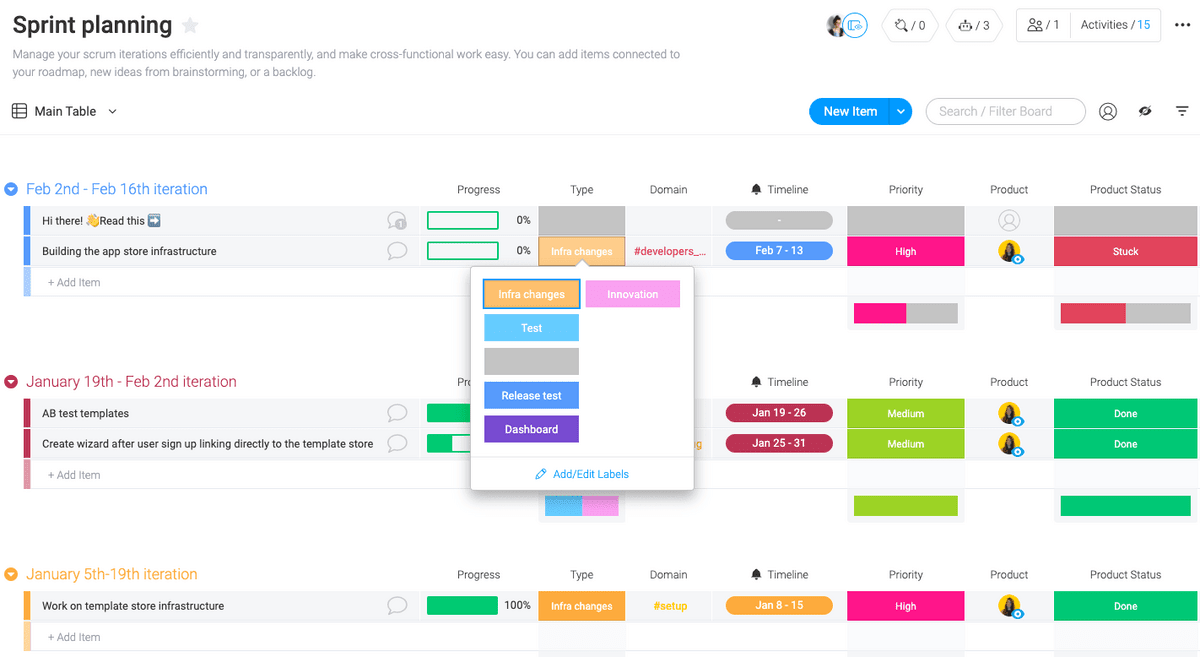
You can also organize tasks by priority, set a timeline, and assign task owners, making it easy to track tasks and team workload as the sprint progresses.
2. Daily Scrum ceremony
- Goal: Ensure the project team has shared visibility of how a sprint is progressing
- Participants: Project team, Product Owner (optional), Scrum Master (optional)
- Frequency: Daily
- Length: 15 minutes
Often called a daily standup, organizations use Scrum ceremonies to ensure each team member is on track with their tasks and the team is set to meet its goals.
During the standup, each team member provides a brief update on what they’ve completed over the last 24 hours, what they plan to tackle next, and any roadblocks they’re experiencing. A manager or Scrum Master should note these challenges and work to immediately remove obstacles so that the team can move forward with their work.
This brief meeting enables seamless communication. With a daily review of team progress, everyone stays motivated and aware of the sprint’s progress. Ideally, this meeting is done while quickly glancing at the tasks on a timeline, which is where monday dev comes in handy.
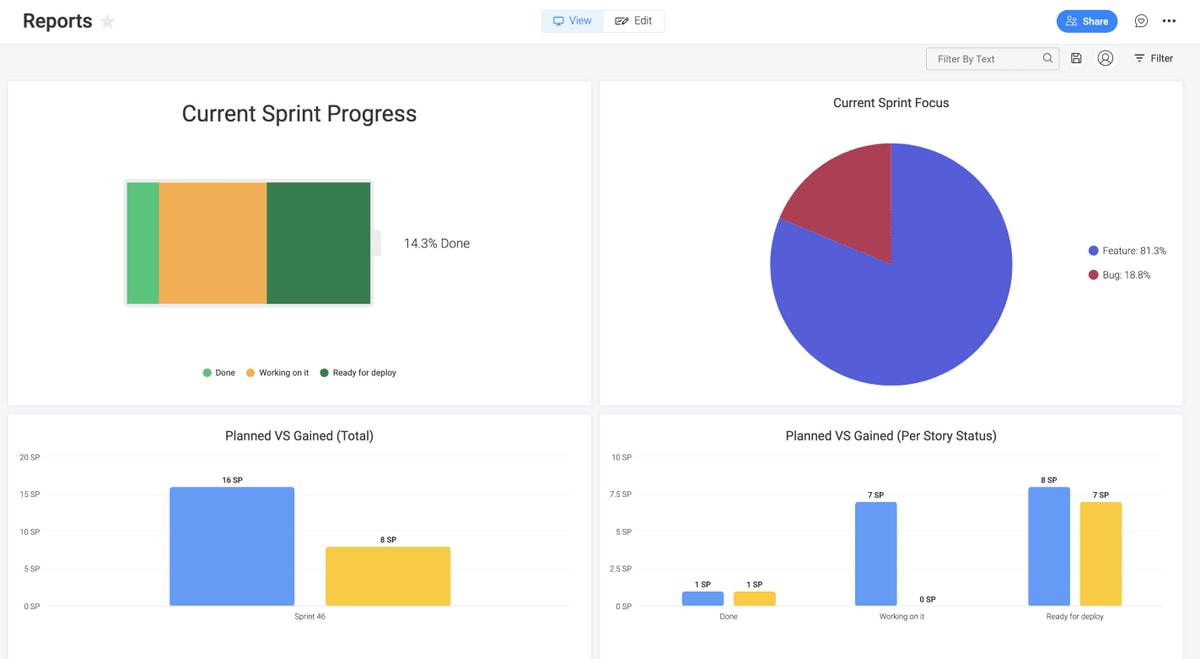
monday dev allows you to see at a glance each team member’s workload so you can quickly access essential information on daily tasks. Additionally, team members can note when they’re stuck on a task so the Scrum Master is aware of obstacles at any time, not only during a standup.
3. Sprint review
- Goal: Discuss and demo completed work, highlight accomplishments, determine next steps
- Participants: Entire Scrum team, Product Owner, business stakeholders
- Frequency: End of each sprint, typically every 1–4 weeks
- Length: Up to an hour per week of the sprint (eg. a 2-hour meeting for a 2-week sprint)
The sprint review meeting is an opportunity for the project team to showcase what they’ve achieved during a sprint to key stakeholders. The Product Owner facilitates the sprint review and gathers feedback from the business on progress-to-date and what needs to be prioritized next.
In monday dev, you can update your product backlog in real-time based on the feedback received from stakeholders, making sprint review meetings more time-effective and targeted.
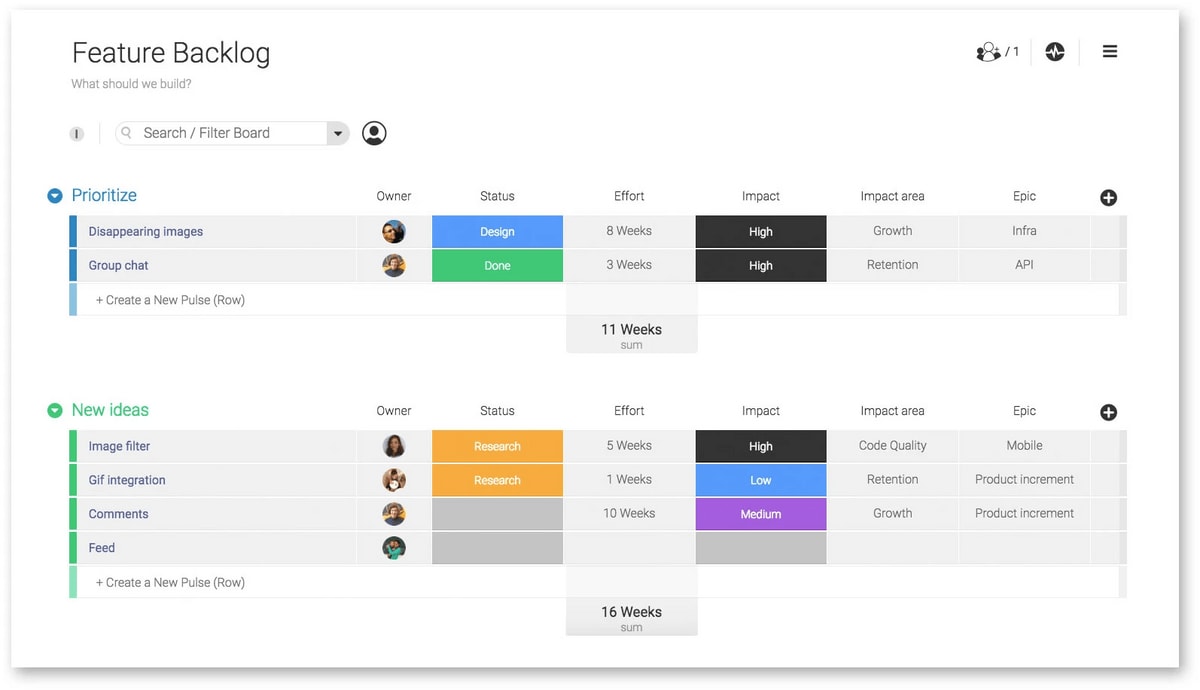
Then, all the information gathered during a sprint review can be used automatically at the start of the next sprint.
4. Sprint retrospective
- Goal: Understand what worked and what didn’t in the last sprint, with a focus on increasing quality and effectiveness
- Participants: The entire project team
- Frequency: End of each sprint, usually every 1–4 weeks
- Length: As long as is required, on average 2–3 hours
Where the sprint review focuses on project progress, the sprint retrospective meeting analyzes the team’s work at the end of a sprint. This ceremony helps Scrum teams focus on the parts of their process that are working well and identify areas to improve. This is essential, as continuous improvement is a core principle of Agile.
Sprint retrospectives can be challenging because they require the project team to honestly appraise how well they’re working together, which requires trust between team members.
It can be tempting to skip the retrospective after an excellent sprint but don’t let it slide. Even experienced Scrum teams benefit from thinking critically about why their work went well.
You can use a sprint retrospective board on monday dev to capture improvements and get feedback on action items from the entire team.
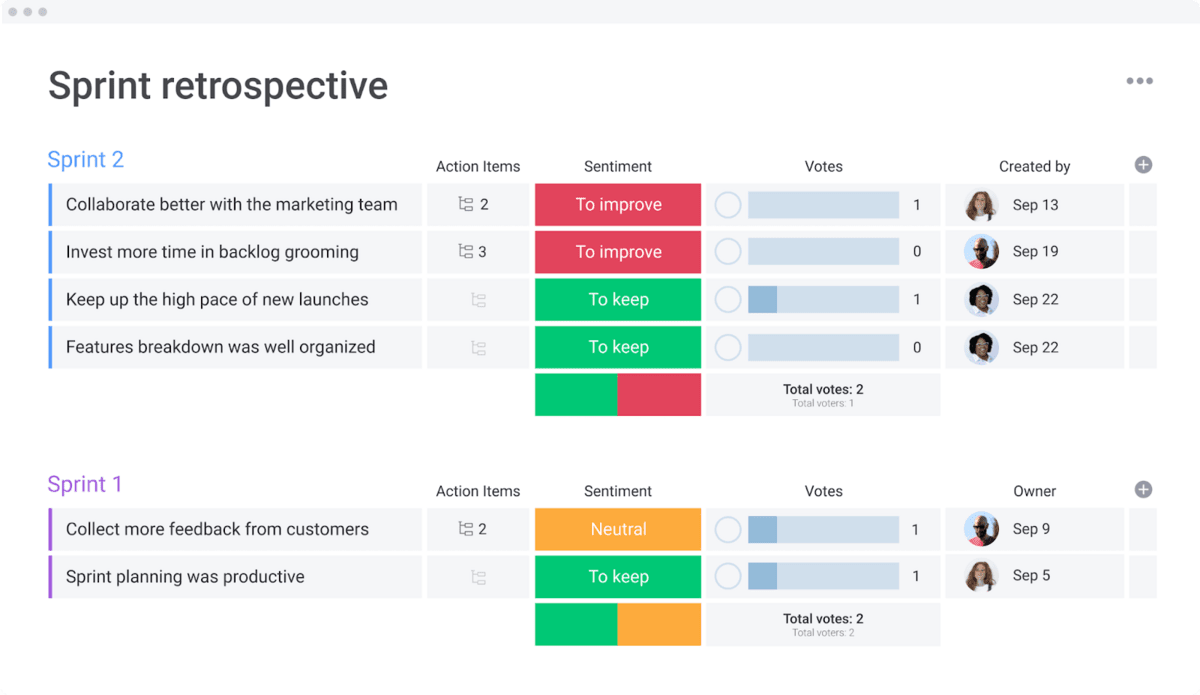
Once the sprint retrospective is over, set deadlines for completing each action item and assign owners. Using automations, set up email notifications to alert the whole team on progress as the task’s status changes.
5. The bonus ceremony: Product backlog refinement
- Goal: Reviewing and prioritizing tasks on the backlog to prepare them for the next sprint
- Participants: The product owner, development team, Scrum Master (optional)
- Frequency: Weekly
- Length: One hour per week
While there are four core Agile ceremonies, some teams use a fifth one throughout a project or sprint’s lifecycle. This ceremony isn’t always recognized as an official ‘Agile ceremony’ or used by all teams, but it can be a helpful ongoing process that functions alongside other ceremonies.
Product backlog refinement, also known as Backlog Grooming, focuses on reviewing and prioritizing tasks that have been backlogged. This is to make sure that the backlog doesn’t get overloaded, and that items are organized, updated, and ready to be actioned with the next sprint.
Key Benefits of Agile ceremonies
Development and IT teams stand to benefit from implementing Agile ceremonies in their project management processes. Studies in Agile methodology show that teams that use Agile practices are 25% more productive than those that don’t. Agile practices, like the four ceremonies, offer a lot of benefits to development teams, such as:
- Quicker feedback loops: Agile ceremonies emphasize ongoing feedback, making it easier for teams to adapt quickly
- Increased visibility: Through ceremonies like sprints and retrospectives, all team members gain a clear understanding of what’s going on in a sprint and project
- Improved collaboration: Daily standups and regular reviews provide ongoing opportunities for team collaboration, leading to better understanding and communication
- Risk mitigation: Agile ceremonies make it easier to spot potential risks earlier on through regular progress check-ins, enabling teams to take a proactive approach
- Continuous improvement: Ongoing improvement is at the core of Agile practices as teams are encouraged to reflect on processes and identify areas for improvements
3 challenges of running Agile ceremonies
Although it seems simple to follow the format for these ceremonies, there are still a few things you might need to stay on top of, especially in less experienced Scrum teams. Take a look at these challenges you might face and tips for managing them.
1. Getting sidetracked
If your organization is new to Agile practices, establishing an effective ceremonies routine can take some getting used to. Off-topic discussions can prevent teams from getting laser-focused during ceremonies.
Even with a well-prioritized backlog, there will be some discussion about what items to carry forward to the next sprint, which, while important to establish, can derail a meeting. With experience and discipline, teams need to be able to keep the discussion on track, which might take a significant culture shift.
This is especially true of standups, where there’s a limited time to discuss daily updates. These 15-minute meetings should focus on what’s been done in the last day and what will be tackled over the next. Anything that requires more information should be set aside for a separate meeting or discussion.
2. Bringing the right people together
Some Agile ceremonies require specific people to be in the room, or not be present at all. Bringing the right people together is the only way to ensure certain goal is met.
A sprint retrospective requires a team to discuss things that didn’t go well, which could be tricky with stakeholders present. Similarly, the Product Owner is essential for sprint planning as they bridge the project team and the business’s requirements. Having the right people at each meeting ensures that everyone is clear on their roles and responsibilities and committed to making the sprint structure work.
3. Not learning from past experience
It’s essential to follow through on recorded action items. If something goes well, reinforce it. If something goes poorly, brainstorm how to remedy it.
While action ownership can be assigned, the responsibility for implementing change falls on all team members. If Agile ceremonies are new to your part of the business, don’t be afraid to look for more experienced mentors who can offer guidance to steer you away from common pitfalls.
Manage Agile ceremonies on monday dev
71% of companies in the US are using Agile methodologies, and while it’s the majority, it still leaves a good portion of teams on the outside. As far as project management solutions go, Agile practices keep entire teams on the same page with task assignments, upcoming deadlines, and planned work.
monday dev can help you accomplish more than just manage your projects. Along with keeping all your tasks, communication, and documentation in the same place, there are several ways that monday dev can help you build ceremonies into your workflows:
- Templates: Get started instantly with customizable templates to help you plan Agile products, like roadmaps, bug tracking, feature requests, sprint management, and more
- Automations: Easily set up rule-based automations to trigger actions and keep your work flowing smoothly while eliminating repetitive administrative tasks
- Permissions: Set access permissions for users inside and outside your organization so you can share information with stakeholders or external Scrum teams.
- Integrations: Avoid disrupting your existing workflow by integrating over 200 different work tools you already use, like GitHub, Figma, and more
- Collaboration: Ensure your entire team is working towards its goals separately and together by syncing all progress on one platform
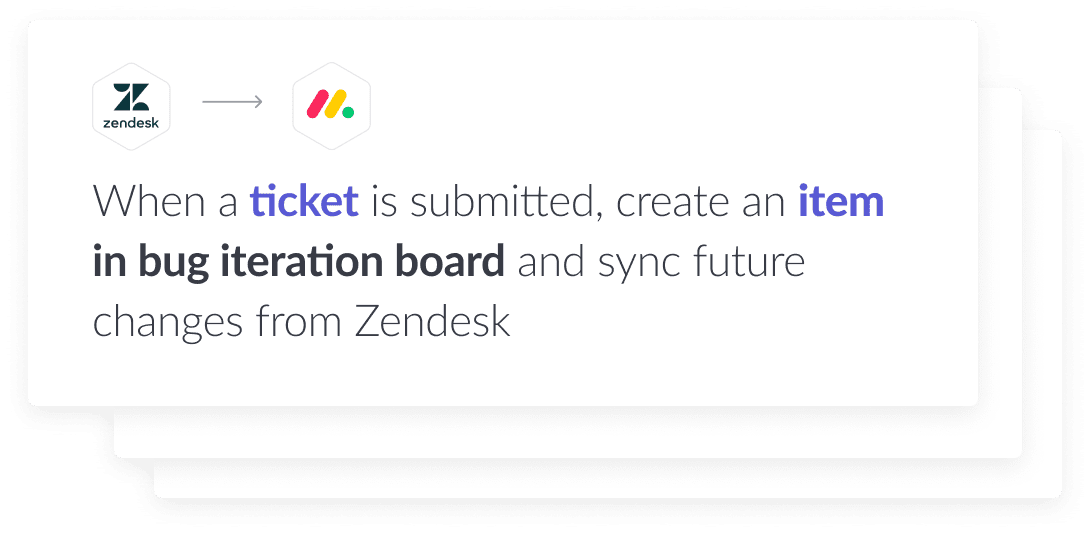
monday dev empowers team members to work their way, with plenty of customization options in each dashboard, including 27+ work views and easy ways to communicate. This way, each team member can focus on their tasks while stakeholders can still access relevant information to get a big-picture view of the status of a sprint and overall project.
Run Agile ceremonies for better project outcomes
Agile ceremonies provide a structured way to track and encourage progress and communication on your project. By conducting these ceremonies regularly, your team will improve their communication and efficiency, helping deliver better projects on time while making customers happier.
With monday dev, the process of planning projects and keeping track of action items from different Agile ceremonies is simpler than ever. Scrum teams can ensure that tasks and information relating to each sprint are stored in an organized and accessible way, helping all team members stay on the same page, which is a critical component to the success of your business’s projects.
FAQs
What is the goal of Agile ceremonies?
The goal of Agile ceremonies is very clear: communication. Throughout the four Agile ceremonies, team members are hyper-focused on communicating everything, including task status, roadblocks, areas for improvement, and more.
Which Agile ceremony is most important?
While all the Agile ceremonies are important, the sprint retrospective is likely the most crucial one. In the retrospective, teams examine their failures and successes to continue adaption, which is an essential component of the Agile methodology.
What is the difference between Agile and Scrum?
The difference between Agile and Scrum is that Agile is more of a philosophy while Scrum is the implementation of that philosophy. Agile is a broad approach to project management that emphasizes flexibility and collaboration, while Scrum is a specific framework that provides a set of roles and events to structure the development process.
- Tags:
- Agile methodology
 Try monday dev
Try monday dev 
